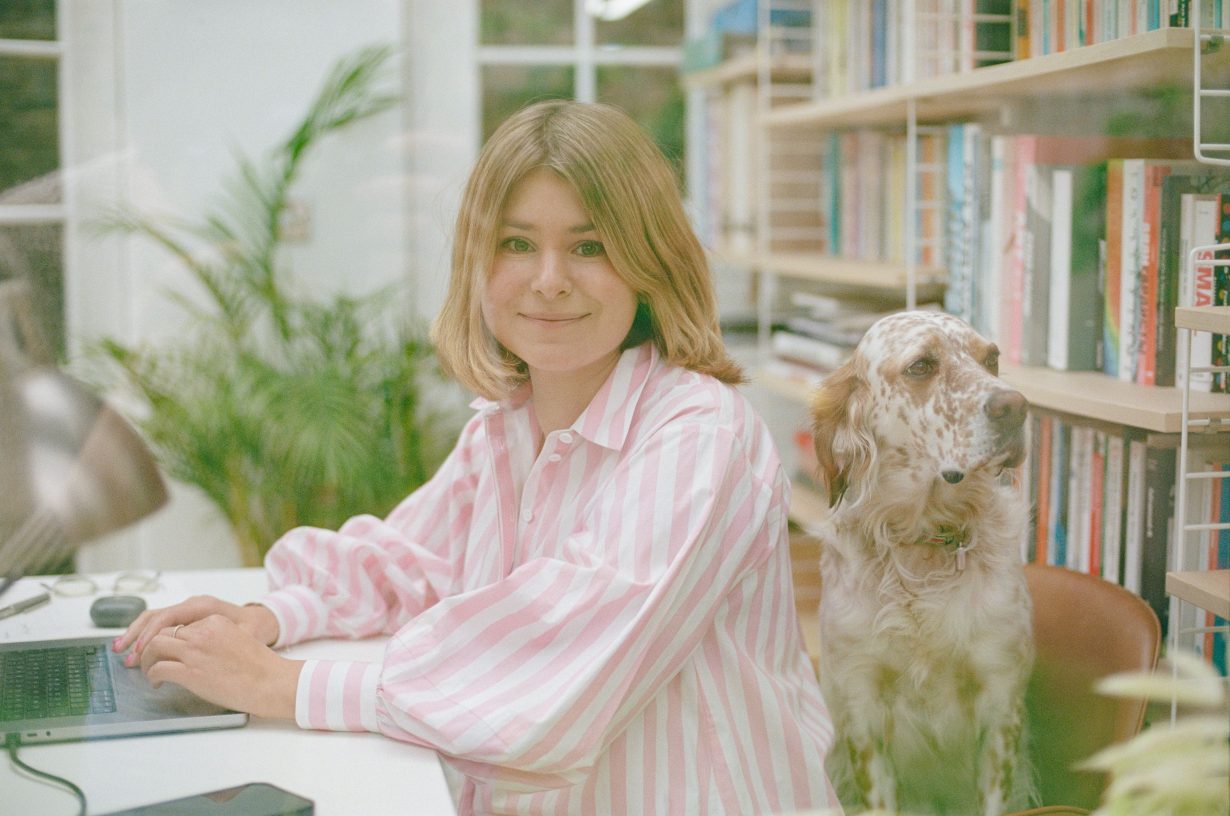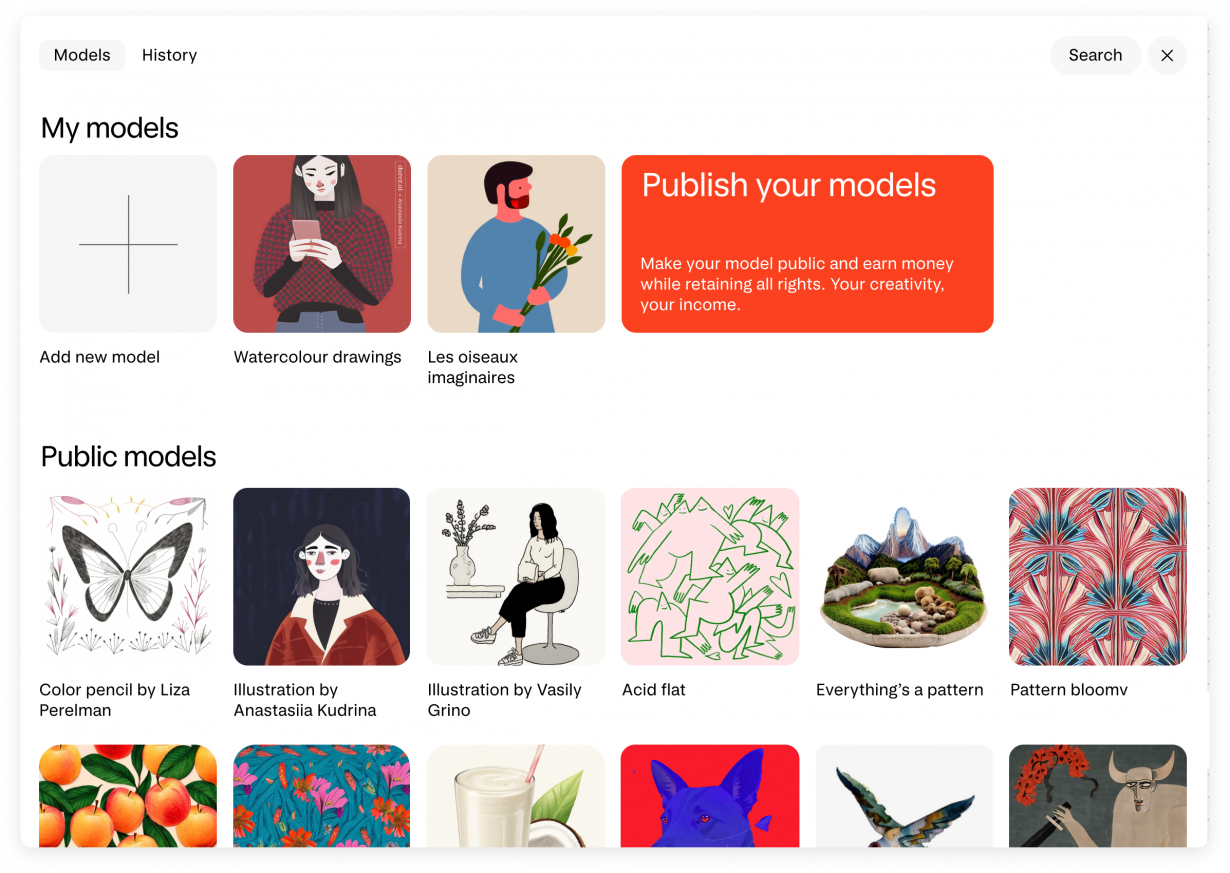ArtReview spoke with founder of Exactly.ai, Tonia Samsonova on AI models, artists’ rights and the possibilities of the collaboration between the tech and creative industries
Exactly.ai was founded as an AI-powered tool for artists and visual creators that allows them to train AI on their own terms. Users can use their own artistic style to develop new imagery and license out their models while retaining legal ownership over their art. Ahead of the inaugural ArtReview Culture Club talk on immersive art with Julianknxx and Marguerite Humeau, Exactly.ai founder Tonia Samsonova sits down with ArtReview to explore the constantly changing landscape of art and tech, and the ways in which it can empower artists.
ArtReview You come from a background in journalism, so what led you to founding Exactly.ai?
Tonia Samsonova When I was a journalist, I saw firsthand the complex and often depressing relationships between media and the tech industry. The spread of social media and advertising technology powered by big data shifted the incentives of journalists who now had to think not only about the quality of their stories, but also the competition from Search and Social Media companies for advertising revenue. Editors have had to think about how to bring audiences to their news outlets; there were more economic incentives to publish ten factually questionable stories with clickbait titles that could be produced cheaply in one day, than one in-depth investigative piece that required a lot of talent and months of research. The lack of economic incentives for high-quality journalism led to the spread of fake information and the polarisation of society.
The media industry seems like it is yet to recover. We see how some news outlets are not around anymore while others switched to a subscription-based model. After ten years, the audience of the media learned that written content varies in quality, and while you can still read social media posts for free, you often have to pay a subscription fee if you want to have access to high-quality journalism. The transition from an old way of working to the new has taken too much time and is even now still being developed.
What happened more than ten years ago between tech and media industries feels remarkably similar to the debate unfolding around AI. To develop Large Language Models (LLM) like ChatGPT and Dall-e, the works of writers and visual artists have been used to train algorithms without their creators’ consent. The creators’ works were appropriated to create a technology that diminished the economic value of their creative output because new technology can generate images and text in seconds with a simple description.
It is already difficult to make a career and earn a living if you are a visual creator. With no clear relationship or ownership between what goes in and what comes out, such AI models risk making the lives of creators even more difficult as some of their roles may be replaced with an AI. Faced with this dilemma, I started Exactly.ai in the hopes of building an equitable relationship between the tech and creative industries, and helping artists retain their rights. I believe that creative jobs will always run on the human’s inspiration and talent, no matter how advanced the technology is.

AR There are other services that generate AI imagery. What sets Exactly.ai apart?
TS Generative AI companies produce images for those who are not professional visual creators. But Exactly.ai is not in the business of creating images, we offer artists a service to make their own personal AI algorithms, trained on their own artwork, to generate images in their style. We envision a future where anyone can create their own version of Midjourney or Dall-e, but in which these algorithms always belong to the artists. It is up to the creators to decide how to use their models. They can either use it for their own creative work or publish their model for licensing while retaining the copyright to the imagery produced. This way, artists preserve their ownership and have the chance to increase their productivity and income using this technology.
AR An important part of developing your AI program involves collaboration. Who have you been working with, and why?
TS Our AI development team relies on the expertise of the art community that participates in the engineering process. AI technology is probabilistic in nature, meaning you only know how good a piece of code you’ve written is when you see the images it creates. A tricky part here is to be able to evaluate the quality of the AI-generated images produced at scale. To make this happen, we established a close collaboration between our creative community and engineers to work as one team.
We also run monthly exhibitions in different cities and galleries worldwide to promote creators using Exactly.ai and show their models to art directors and designers, who can then commission the illustrators we represent. This month, we are very proud to have our show of Exactly.ai models being displayed at the Shoreditch Arts Club, which opens on 8 September. The AI models that will be displayed are available online for you to try out and create images in the styles of different artists.
AR How is Exactly.ai helping artists?
TS While we see many people using Exactly.ai for their art projects, we think about our users as visual creators who turn to Exactly.ai to simplify their daily routines. Most people who make art also work on commissions for brands and companies. We allow creators to do and earn the same amount while investing less time. The additional time gained can now be spent more creatively. If artists can earn some passive income from people prompting their specific models, then this frees up some time that artists can spend experimenting on their practice.
AR How do you see Exactly.ai impacting contemporary artists?
TS We are starting to see artists test the boundaries and use the Exactly.ai technology in unexpected ways. While creators most commonly feed the algorithm their own work and then create images within their style, some go further than that. When artists agree to collaborate on projects, the artwork they create is a blend of both styles and ideas. For example, photographs by one creator have been blended with the visual style of another artist’s and the images result in novel concepts and ideas.
AR A US Federal Judge recently ruled that artwork generated by artificial intelligence is ineligible for copyright protection. How does this ruling affect the future of Exactly.ai?
This is the start of a decades-long process to establish the legal frameworks and precedents that will ultimately govern AI.
There is obviously a difference between a company generating AI images by crawling through all images on the web (without acquiring licenses), and an artist training AI on their own copyrighted content to experiment with. Doing so allows artists to become more efficient while retaining rights to their style, their personal model and any subsequent art made from it. They can even license it out.
Over time, the difference between training models will be reflected in law. We will work with the legislators to help explain the difference and become a voice for the creators. In July, I met with members of parliament from both parties to discuss these issues and we will continue to make our case. In the meantime, we can define how these systems work in practice and build tools that support artists.
We are quite optimistic about the approach of the British government towards the AI, which is quite different from the US and EU. Essentially Britiain is more open and prepared for the AI-led innovation as they have been empowering startups who are exploring the space, financial institutions who invest in the space and early adopters who would like to experiment with an AI-generated content. While the US market has more resources to invest into the new technology, Britain is trying to create a more beneficial legal environment for the AI companies and creatives to flourish. More practically, it means that if you are a creator who is using AI for your own art experiments, it would be easier for you to secure a copyright to an artwork you have created with the new technology in Britain.

AR It seems to me that Exactly.ai can have implications in other fields like gaming or animation. How do you envision Exactly.ai innovating other industries?
TS Yes, we are actively working on this, but the technology is not there yet. The technology currently being used in moving images are just masks, like filters you might see on social media, on top of recorded videos, which has nothing to do with the process of creating animations.
Classical animation does not look like real life. Movements are exaggerated. Objects do not operate under the laws of physics and biology. Classical animation, where you have to draw key frames and fill in the in-betweens, is a super time-consuming process. Current AI tools available on the market don’t solve this problem, but it’s only a matter of time.
AR What is next on the horizon for Exactly.ai?
TS This week, we announced that creators can not only train AI models for their private use but also publish them on our platform. If you go to the Exactly.ai models page, you will see the first fifty models published by artists in our community. Visitors are invited to generate images with this diverse collection of personal styles. This allows any user, designer or art director to implement their ideas using the styles of artists they like without having to commission them directly. Importantly, artists retain copyright to all of the images created with their models by others, and these images cannot be used for commercial purposes unless a user purchases a license from the artist. At Exactly.ai, we do not take cuts from this licensing so all the proceeds of those deals go directly to the creator. We believe this can help establish a relationship where artists not only who own the copyright to their existing work, but also the technology that produces these images. In the long run we see it as a foundation of the fair interaction between tech companies and creatives.
